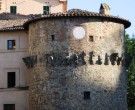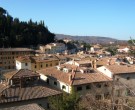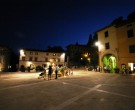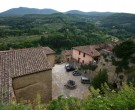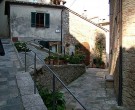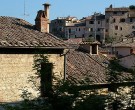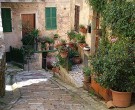> Home > What to visit > Old Town

Cetona Cetona
OLD TOWN
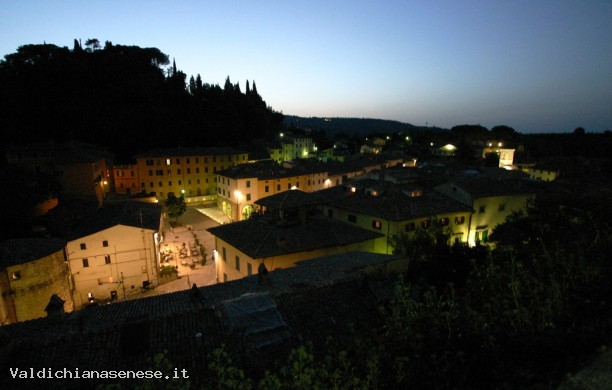
PHONE NUMBERS AND TIMES
Cetona
Business card (vCard)
The pilgrims , during the XIII century, after coasting the Chiana marsh, and travelling along the secondary route of the Via Francigena, Arezzo – Bolsena, when they would get to Chiusi ,and they would look towards the West, they would see a mountain with a sweet and maternal profile as that of a woman’s breast and, at its foot , a castle with several towers, that revealed an important human settlement ; such castle was the Castle of Scitiona, already present at the time of Charles the Big One. The small houses roosted astride the second town walls were the homonymous village. Since little remains to document the life of the village people at that time, we can only imagine what it could have been like. They probably were innocent victims of the whirlpool of international political vicissitudes .It was probably infernal, since the castle, on the border between the Republic of Siena and the State of the Church, represented a continuous exchange object, submitted to inroads, plunders and fire. Not even during the rare times of peace, the days went by in an easy and happy way: scanty harvests from the barren fields ripped from the woods, taxes, duties, overtaxes, diseases and plagues, turnips for lunch and for dinner and not much more on special occasions. On the other hand the feudal lord , at the time , vassal of Orvieto, didn’t really have a bad time, considering that he supported a great number of soldiers and participated frequently to quarrels among states. As a matter of fact , an expeditionary force from Cetona , took part in the battle at Monteaperti against Siena. In 1300, year of the most famous Jubilee in history, with Bonifacious VIII as pope, the lord went to Rome with an escort of thirty knights , to have some of his sins forgiven in exchange of a great deal of money. Every forty or fifty years the Castle would change owner, obviously after a precautionary siege, plunder and houses and women taken by force. In 1450, when the Castle of Cetona had been a vassal of Siena for only a few decades, a concentrated group of starving people from Cetona created an armed group and started plundering the territory of Castel delle Pieve ( nowadays City of Pieve). In 1555, although very faithful to the Republic of Siena, as did the Fortress of Montalcino, Cetona, itself was forced to surrender to the Medici. A period of peace, stability and in a certain way prosperity set in . The by-laws allowed a wide range of freedom in self government, in proportion , more than today: in 1700 ( by this time, it’s recent history) the citizens of Cetona elected the mayor, the doctor and the preacher, all sumptuously remunerated. There was a Custom Office at Fenoglio, many craftsmen, among which several weapon makers specialized in the making of arquebuses. There were fourteen churches inside and outside the city walls, a hospital and a hotel for pilgrims, there were three hundred fires for 1500 adult citizens. Eleven mills grinded wheat, that was surely abundant, the town was so rich that it was able to generously finance the army of Garibaldi, with a loan that could be paid back at the end of the mission, but obviously when the request was made in 1870, nothing was paid back. The town, during that part of the century, built , on its own ,the roads that take to Chiusi and San Casciano; in 1879 the town built a water main for drinkable water , 5km. long; the only town in the province with six small fountains and a monumental fountain in the main square. In 1900, it was the first town to have electricity, produced by a steam engine. Being on the borderline with the State of the Church, the town became a refuge for political refugees. It was also a center of an important section of the Masonry, who financed the lecture hall, later Club Luca Cortile, the kindergarden, and the people’s library . Later on , the hospital Umberto I was built ; the “Family Home” for the elder and for the disabled at work was also founded and it still exists nowadays.
STAY NEARBY
PODERE SAN GIOVANNI
CETONA
Agri-turism Immersed in the green Tuscan countryside, the San Giovanni holiday farm is l...AGRITURISMO COCCIANO
CETONA
The "Agriturismo Cocciano" is located in a typical tuscan farmholiday dating bac...AGRITURISMO BELVEDERE
SARTEANO
This old stone farmhouse, which has been completely restored, is situated in the heart of ...DINING & ENTERTAINMENT NEARBY
Teatro degli Arrischianti
SARTEANO
Il Teatro Comunale degli Arrischianti di Sarteano è all'interno del Palazzo Comuna...Parco delle Piscine
SARTEANO
Situatoa 573 metri di altitudine, in prossimità del centro storico di Sarteano,&nbs...Teatro Mascagni
CHIUSI
A dare i natali al teatro di Chiusi è l'Accademia dei Filateti, fondata nel 1818 e ...



